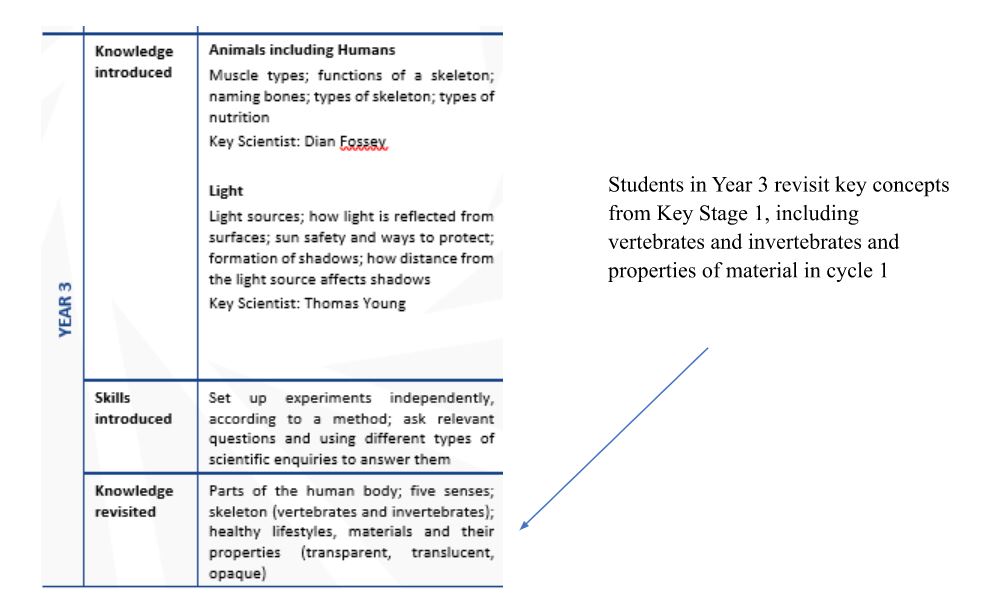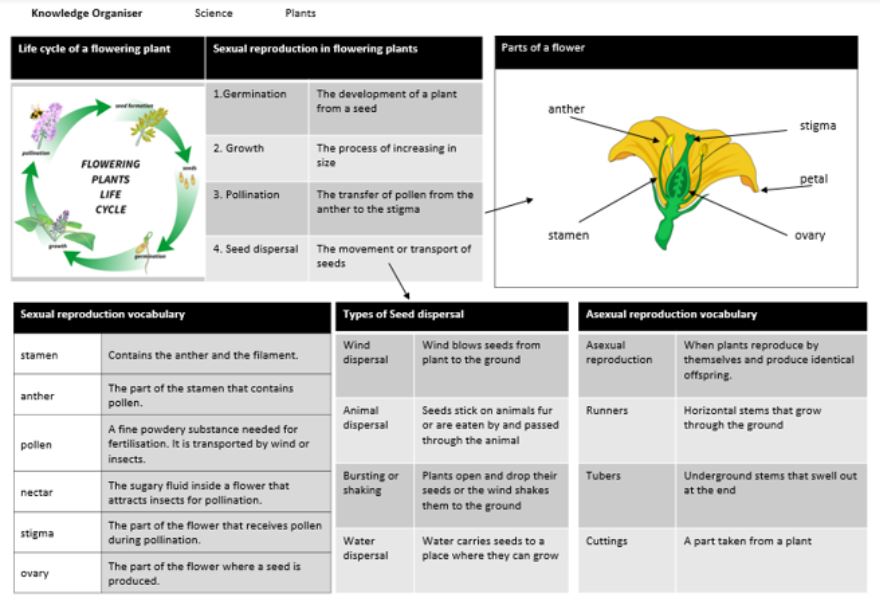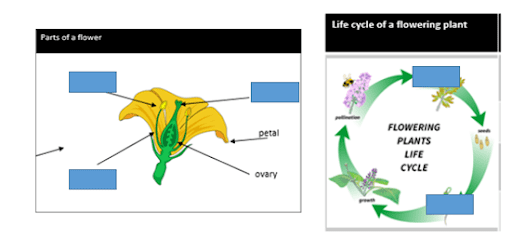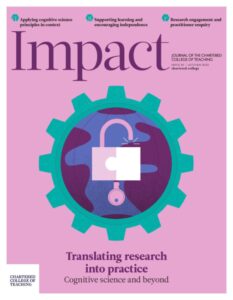Using cognitive science principles to design a knowledge-rich primary science curriculum

Rebecca Wardell, Primary Trust Assistant Principal, Dixons Academies Trust and Dixons Music Primary, UK
In 2017, a major report funded by the EEF (Nunes et al., 2017) found strong evidence of a link between socio-economic status and science attainment. This science attainment gap becomes apparent at Key Stage 1 and gets wider throughout the rest of primary and secondary education. As part of the Dixons Trust, where our mission is to ‘challenge educational and social disadvantage in the North’ and where our primaries are predominantly in some of the most deprived areas in the UK, it was vital that we created and devised a primary science curriculum that would address this attainment gap early, and boost attainment for disadvantaged students in primary science.
To boost attainment and address this gap, we decided that our key aim for our science curriculum was that all students would know and retain the fundamental scientific knowledge from biology, chemistry and physics, providing a foundation for secondary science learning and beyond. This then posed the question: How do we support our students not only to learn but also to retain this key scientific knowledge?
A team of science leads across the Trust turned to cognitive scienceThe study of the human mind, such as the processes of thought, memory, attention and perception research and principles to answer this question, including:
- spaced practice
- building secure schemas
- managing cognitive load
- retrieval practice.
Spaced practice
Spaced practice (or distributed learning) is the cognitive science principle that material is more easily learnt when broken apart by intervals of time (Roediger et al., 2011). The EEF (2021) argues that having pupils revisit key concepts, ideas or skills over longer periods of time, could improve learning retention. When mapping out the curriculum, we ensured that the science curriculum revisited key concepts that we wanted our students to remember every year – for example, the difference between vertebrates and invertebrates was always taught to all year groups during their animals topics, but the content of the unit reflected the ability of the year group to whom it was being taught (see Figure 1). We also ensured that key concepts were revisited in the form of retrieval practice, which will be discussed later in the article.

Figure 1: Example from science curriculum overview
Building secure schemas
After spending time ‘backwards planning’ and ensuring our curriculum was coherent, vertically integrated and developing skills and knowledge over time, it was essential that we considered:
- the crucial knowledge and concepts that we wanted students to remember for each unit
- their prior knowledge before starting the unit
- how we could support students to connect prior knowledge to new knowledge through our understanding of schemas.
Schemas (or mental models) are the structures that organise knowledge in the mind. When children learn something new, their mind connects the new information with pre-existing knowledge. For students to be successful in a subject, it is argued that they must not only have a foundation of factual knowledge but must also be able to understand those facts in the context of a conceptual framework and organise their knowledge to facilitate retrieval and application (Bransford et al., 2000). However, young children can come into science lessons with misconceptions; therefore, it is important that teachers support students to make these connections, and to organise, compare and elaborate on these ideas to build secure schemas. It has been argued that with the careful design and use of knowledge organisers, we can support pupils to construct these schemas (Paas et al., 2004). At Dixons, we define a knowledge organiser as a ‘one page document which presents curated, essential, organised knowledge with clarity.’ Knowledge organisers were created for each unit, and included the key concepts, knowledge and vocabulary that students would need to be successful in the unit. Students could use the knowledge organisers to revise key content and teachers could use the knowledge organisers to refer to in their lessons, to discuss definitions and support students in making links between ideas.

Figure 2: Example of a knowledge organiser
In the example in Figure 2, the knowledge organiser (Year 5 plants) has been created so that the pollination stage of the life cycle and its definition has been linked to the parts of a flower, so that students are encouraged to draw links between pollination and the parts of the plant. This has also been done for the seed dispersal section. This encourages students to see the clear links between the concepts and the lessons in the unit. The vocabulary definitions also support students to deepen their understanding of the key concepts.
Managing cognitive load
Once knowledge was codified, we focused on how the material would be taught so that all children could learn and retain it. In primary science, students learn new vocabulary and complex concepts. This can challenge working memory, which can become overloaded when presented with large amounts of complex information (Kirschner et al, 2006). When planning each lesson, it was important that cognitive load was carefully considered, so we used a consistent lesson structure that breaks up complex content into more manageable chunks (Figure 3).
| Do now | Students complete a retrieval practice activity that encourages them to recall and elaborate on prior knowledge. These activities are related to the new knowledge that will be delivered to build on concepts and secure schemas. |
| New learning | Students will be introduced to key scientific vocabulary and the new idea/concept. |
| Talk task/Let’s explore | Students will have time to use the new scientific language verbally with partners or groups or explore the new key concept in a physical way. |
| Develop learning | Students will then be provided with some more information that deepens their understanding of the new vocabulary or key concept that is being taught. |
| Independent task | Students will complete a task that allows them to apply the new concept. |
| Consolidation | Students will answer a key question or concept cartoon that allows them to deepen their new knowledge. |
Figure 3: Lesson structure for learning new material
Providing this consistent lesson structure ensured not only that teachers had support with how to deliver difficult concepts for young children, but also that students were given time to process a new concept, as well as link it to previously learnt information. We ensured that effective formative assessment was a key focus for each part of the lesson and that the scheme of work planned for any misconceptions and how to address them.
Retrieval practice
Another key element of the scheme was that there were opportunities for knowledge retrieval at the start of each lesson. Retrieval practice is the act of recalling previously learnt information, and is often done through low-stakes quizzes and tests. Research has found that retrieval practice aids later retention (Roediger et al., 2011) and encourages students to strengthen their memory of key concepts. It was important to us that retrieval should produce meaningful, long-term learning (Karpicke, 2012). We wanted our students to be able to make links and connections and provide rich explanations as well as repeat facts. Retrieval practice activities were devised from our knowledge organisers and were planned to ensure that students remembered key scientific concepts and vocabulary over time – revisiting concepts from past units as well as previous years.

Figure 4: Example retrieval practice activity
In the example in Figure 4, key words have been covered up on the diagrams. Teachers can allow students to simply ‘fill in the gaps’. However, for retrieval to be more purposeful, it is important again to ensure that students elaborate and make links and connections between ideas and concepts. Teachers can promote elaboration through questioning – for example, ‘Which parts of the plant are essential for pollination to take place and why?’ or ‘Talk to me about the key function of the anther’.
Conclusion
Cognitive science research supported us in designing a curriculum that taught key concepts spaced out over time, supported students to link concepts through the use of knowledge organisers, and that planned for students to retrieve knowledge from previous years. Research into cognitive load theoryAbbreviated to CLT, the idea that working memory is limited and that overloading it can have a negative impact on learning, and that instruction should be designed to take this into account also supported us to devise our six-part lesson structure, which chunked up content to make it more accessible for all, and ensured that students understood scientific vocabulary and key concepts.
This curriculum has been trialled over the last two years at Dixons Music Primary. It is important to remember that a well-designed curriculum alone cannot support students’ retention of knowledge. This is why staff have received regular half-termly training in cognitive load and cognitive principles to understand the purpose behind the new curriculum and how children learn, as well as regular science subject knowledge CPD meetings.
Although we are still in the early stages of implementation, a recent DfEDepartment for Education - a ministerial department responsible for children’s services and education in England ‘deep dive’ in science tested students at random and found that students in various year groups (including those with special educational needs and disabilities and those receiving pupil premiumAdditional funding for publicly funded schools in England to raise the attainment of disadvantaged pupils of all abilities funding) had a solid and secure understanding of scientific concepts and retained key content from previous years. Pupil voice questionnaires also found that students understand the purpose of retrieval practice and how they can use their knowledge organisers to support learning and retention and to build secure schema.
With many schools now focusing on their science curriculum due to the new subject ‘deep dives’ in the revised OfstedThe Office for Standards in Education, Children’s Services and Skills – a non-ministerial department responsible for inspecting and regulating services that care for children and young people, and services providing education and skills framework, I would recommend using these cognitive science principles to inform curriculum design and to support students to learn and retain key scientific concepts and knowledge.
- Bransford J, Brown A and Cocking R (2000) How People Learn. Washington: National Academy Press.
- Dunlosky J, Rawson KA, Marsh EJ et al. (2013) Improving students’ learning with effective learning techniques: Promising directions from cognitive and educational psychology. Psychological Science in the Public Interest 14(1): 4–58.
- Education Endowment Foundation (EEF) (2021) Cognitive science approaches in the classroom: Guidance report. Available at: https://educationendowmentfoundation.org.uk/education-evidence/evidence-reviews/cognitive-science-approaches-in-the-classroom (accessed 19 July 2022).
- Karpicke JD (2012) Retrieval based learning: Active retrieval promotes meaningful learning. Current Directions in Psychological Science 21(3): 157–163.
- Kirschner PA, Sweller J and Clark RE (2006) Why minimal guidance during instruction does not work: An analysis of the failure of constructivist, discovery, problem-based, experiential and inquiry-based teaching. Educational Psychologist 46(2): 75–86.
- Nunes T, Bryant P, Strand S et al. (2017) Review of SES and science learning in formal education settings. Education Endowment Foundation. Available at: https://royalsociety.org/~/media/policy/topics/education-skills/education-research/evidence-review-eef-royalsociety-22-09-2017.pdf?la=en-GB (accessed 19 July 2022).
- Paas F, Renkl A and Sweller J (2004) Cognitive load theory: Instructional implications of the interaction between information structures and cognitive architecture. Instructional Science 32: 1–8.
- Roediger H, Putnam A and Smith M (2011) Ten benefits of testing and their applications to educational practice. Psychology of Learning and Motivation 55: 1–36.











Brilliant article. Clear and concise with excellent worked examples, applying the cognitive science principles to curriculum design. Will be sharing with colleagues, as best practice. Thank you.